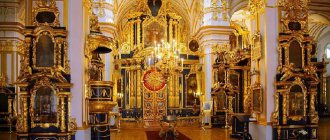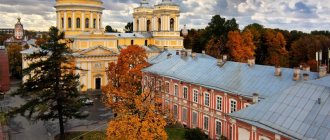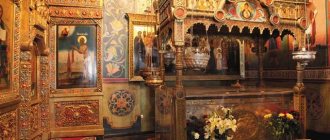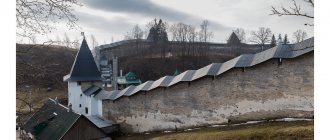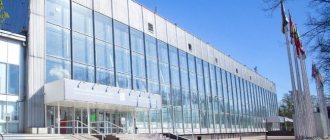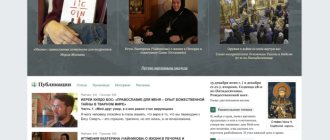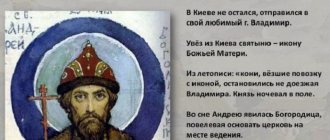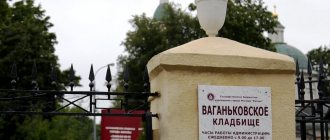| Moscow Church of the Intercession of the Blessed Virgin Mary on the Moat. |
Moscow Cathedral of the Intercession of the Blessed Virgin Mary on the Moat (St. Basil's Cathedral)
, a branch of the State Historical Museum
- Thrones: Intercession of the Most Holy Theotokos (main), Adrian and Natalia, Velikoretsky image of St. Nicholas the Wonderworker, John the Merciful, Life-Giving Trinity, Entry of the Lord into Jerusalem, St. Basil's, Varlaam of Khutyn, Nativity of the Most Holy Theotokos, Alexander of Svir, Gregory the Illuminator
- Address: Russia, 103012, Moscow, Red Square, 2
- Directions: metro Kitay-Gorod, metro Okhotny Ryad
- On the map: Yandex.Map, Google map
The Intercession Cathedral was erected on Red Square in 1555-1561 in memory of the annexation of the Kazan kingdom - one of the most important events in the era of strengthening the Russian centralized state.
The victory over Kazan in 1552 was the first major foreign policy success of the young Tsar Ivan IV the Terrible (the first two campaigns in 1547 and 1550 ended in failure); with the annexation of the Kazan and Astrakhan (in 1554) kingdoms, he also began to be called the Tsar of Kazan and Astrakhan. A symbolic place was chosen for the construction of the temple - on the border of the Kremlin and Posad, next to the moat that surrounded the Kremlin walls (hence the names of the temple - “Protection on the Moat at the Trinity Gate” and “Trinity on the Moat”). Chronicle sources indicate that in its final form the idea of the temple-monument took shape and began to be implemented in 1555. The depth of the plan and the originality of its implementation indicate the undoubted involvement in the “development of the project” of St. Macarius, Metropolitan of Moscow and All Rus', and Tsar Ivan the Terrible.
| St. Basil's Cathedral on Red Square |
Nine separate churches were erected on a single foundation, with one central one, crowned with a large tent, surrounded by eight church pillars arranged crosswise in plan.
The dedications of the thrones reflected the main stages of the Kazan victory and the idea of heavenly protection of the Russian army. The central church was consecrated in honor of the Intercession of the Most Holy Theotokos - on this day, October 1, 1552, the attackers launched a powerful attack, the success of which was crowned with the capture of the city the next day. Dedications of thrones in the name of Saints Cyprian and Justinia (October 2 - capture of Kazan), Patriarchs of Constantinople Alexander, John and Paul the New and Venerable Alexander of Svir (August 30 - Russian victory on the Arsk field), Gregory Bishop of Greater Armenia (September 30 - the beginning of the assault on the city), Varlaam Khutynsky (November 6 - the Tsar’s return to Moscow). The names of the thrones in the name of the Holy Trinity and the Entry of the Lord into Jerusalem have a symbolic meaning - and also connected with the Kazan campaign. Only the ninth throne was dedicated to an event not related to the “Capture of Kazan”. On June 29, 1555, the image of Nikola Velikoretsky was brought to Moscow from Vyatka. Numerous miracles and healings from this image occurred both on the way to the capital and in Moscow, in the Assumption Cathedral. To commemorate this manifestation of God's grace, the ninth altar of the church under construction was consecrated in memory of Nikola Velikoretsky; later it contained a copy of the miraculous icon made by Metropolitan Macarius himself. The construction of the stone Intercession Cathedral, which began no later than the spring of 1555, lasted five and a half years. On October 1, 1559, according to the Nikon Chronicle, all the churches were consecrated, except for the central Church of the Intercession, the construction of which had not yet been completed. The date of completion of construction and consecration - June 29, 1561 - was determined only during the restoration work of 1957-1961, when restorers discovered the text of the temple “chronicle” preserved under late plaster, made at the base of the main tent.
For a long time, based on memoir sources of Western origin, it was believed that the creators of the temple were foreign architects. The honor of discovering the names of Russian architects who embodied the idea of a tsar and metropolitan in stone belongs to the archpriest of the Intercession Cathedral Ioann Kuznetsov, who at the end of the 19th - beginning of the 20th century discovered the names of the builders in the chronicle sources of the 17th century - Barma and Postnik “with their comrades”.
A new page in the history of the temple is associated with the glorification in 1588 of the Moscow holy fool St. Basil the Blessed, who died on August 2, 1557 and was buried under an arch near the walls of the cathedral that was then under construction. In it, over the relics of the saint, between the northern chapel of the Holy Trinity and the northeastern chapel of the three Patriarchs, a stone tent was built. In 1588, the arch was dismantled and, by order of the son of Ivan the Terrible, Fyodor Ioannovich, the church (mortirium) of St. Basil was erected. In 1672, the Church of St. John the Blessed was built at the site of his burial.
In the 17th century, above the northern part of the church of St. St. Basil's Church was built in Feodosia, and at the end of the 18th century it was turned into a sacristy - a repository of church valuables. At the beginning of the 21st century, it houses an exposition of the exhibition “Shrines of the Intercession Cathedral”, which presents unique examples of ancient Russian painting, book and applied art that belonged to this temple during the 16th-20th centuries, as well as rarities related to the history of the construction of the cathedral.
The cathedral became a place of crowded and inexhaustible pilgrimage to the “holy healing tomb” of St. Basil. Unlike the churches of the Intercession Cathedral, where services were held on the days of the twelfths and patronal feasts, in the church of St. St. Basil's service was daily. This was the reason for the appearance of the popular name of the Intercession Cathedral - “Church of St. St. Basil's.
Near the temple “on the Moat”, according to his will, another holy fool, John the Great Cap (+ 1589), was also buried.
In the second half of the 16th-17th centuries, the Intercession Cathedral was the semantic center of the celebration of the Entry of the Lord into Jerusalem: a solemn church procession led by the Tsar and the Patriarch, called the “procession on a donkey,” headed to it from the Assumption Cathedral of the Kremlin.
In 1737, during a big fire, the cathedral was badly burned; its restoration was carried out by the architect Ivan Fedorovich Michurin.
As a monument of national and world significance, the Intercession Cathedral was one of the first to be taken under state protection by decree of October 5, 1918. At the end of 1919, services in the Intercession Cathedral were stopped, but in St. Basil's Church they continued until 1928.
In 1923, the historical and architectural museum “Pokrovsky Cathedral” opened (since 1928, a branch of the State Historical Museum).
In the 1920s, extensive scientific and restoration research was launched on the cathedral, thanks to which it became possible to restore its original appearance and recreate the interiors of the 16th-17th centuries in individual churches. From this moment to the present, four global restorations have been carried out, including architectural and pictorial works.
In the 1960s, unique restoration work was carried out: the temple chronicle was opened, in which the builders indicated the exact date of completion of the cathedral; The iron coverings of the domes of the cathedral churches were replaced with copper ones.
In the interiors of four churches, iconostases for the 16th century were reconstructed, consisting entirely of icons of the 16th-17th centuries, among which there are rarities (“Trinity” of the 16th century, “Alexander Nevsky in the Life” of the 17th century). In the remaining churches, iconostases from the 18th-19th centuries have been preserved. Among them are two unique ones from the Moscow Kremlin from the first half of the 18th century.
Church life returned to the Intercession Cathedral in 1990, on the patronal feast day, when on October 13, after a 70-year break, an all-night vigil was served, and on October 14, the Divine Liturgy was celebrated by Patriarch Alexy II of Moscow and All Rus'.
By decree of the President of the RSFSR dated November 18, 1991, the Russian Orthodox Church was allowed to hold regular services in the Kremlin cathedrals and St. Basil's Cathedral. In accordance with this decree, an Agreement was concluded between the Ministry of Culture of the Russian Federation and the Moscow Patriarchate in November 1992 “On the use of the temples of the Moscow Kremlin and the Church of the Intercession on the Moat (St. Basil’s Cathedral) on Red Square in Moscow” between the Ministry of Culture of Russia, the Moscow Patriarchate, Museums Moscow Kremlin and the State Historical Museum. The Intercession Cathedral is used both as a museum (a branch of the State Historical Museum) and as a temple in which the Russian Orthodox Church holds divine services: on the days of the main altars (the Intercession and St. Basil's Day), patriarchal or bishop's services are held. At the shrine of St. St. Basil's akathist is read every Sunday.
On August 15, 1997, after restoration, St. Basil's Church was opened, in which regular services began to be held.
The Intercession Cathedral is one of the most outstanding monuments of Russian history and culture; it is classified as a particularly valuable cultural heritage site of the peoples of the Russian Federation and is included in the UNESCO World Heritage List.
ADDITIONAL INFORMATION: ADDRESS. TELEPHONE. HOW TO GET THERE
Address: Moscow Red Square, 7 (metro station Ploshchad Revolyutsii, Teatralnaya, Okhotny Ryad, Kitay-Gorod) Phone (administrator) Official website: shm.ru
Opening hours: September 1 – November 4: 11:00–18:00, daily; November 5 – April 30: 11:00–17:00, daily; May 1 – May 31: 11:00–18:00, daily. The first Wednesday of the month is a sanitary day; June 1 – August 31: 10:00–18:00, daily. The ticket office and area close 45 minutes before. until the museum closes. In summer, the territory of the Intercession Cathedral is open from 9:00 to 19:00, daily. At temperatures below -15, the museum reduces its opening hours. Please check the museum's closing time by phone. During the winter and spring school holidays, the museum's opening hours are extended by 1 hour.
Photo gallery
St. Basil's Cathedral history
Anyone who enters Red Square immediately notices the bright domes and graceful contours of St. Basil's Cathedral.
Construction of the temple lasted 9 years. The architects were, according to one version, the masters Postnik and Barma, and according to another, an unknown architect. The legend agrees on only one thing - the builders of the temple were blinded by order of Ivan the Terrible.
At first it was a memorial complex of a tented church surrounded by 9 small churches - symbols of major victories over Kazan. The famous figured domes appeared at the end of the 16th century, and a little later a bell tower was built there. During its history, the cathedral suffered from many misfortunes - first, a fire in 1737 destroyed it almost completely, then the cathedral was damaged during the siege of the city by Napoleon's troops. In Soviet times they even wanted to demolish it.
Now the temple is used for worship and as a memorial and historical complex. Its churches house religious relics - the relics of St. John the Wonderworker, ancient icons and religious objects.
The official name of this majestic temple is the Cathedral of the Intercession of the Blessed Virgin Mary on the Moat. But for most tourists around the world it is known as St. Basil's Cathedral, a brief description
which you will find in this article.
He successfully survived the change of eras and ruling elites, numerous wars and revolutions, and even the Soviet fight against religion. Today, St. Basil's Cathedral in Moscow
remains its main attraction, the calling card of the capital.
Moscow Church of St. Basil of Caesarea on 1st Tverskaya-Yamskaya
| Church of St. Basil of Caesarea on 1st Tverskaya-Yamskaya |
The famous, but not preserved to this day, church in the name of St.
Basil of Caesarea, one of the most luxurious and rich in old Moscow, stood before the revolution on the corner of 1st Tverskaya-Yamskaya and Vasilievskaya streets. Its foundation in the ancient Tver settlement of Moscow coachmen is usually associated with the name of Grand Duke Vasily III and his namesake, although there is a version that the church was built by settlers from Pskov, who consecrated it in memory of the Church of St. Basil of Caesarea, which stood in their hometown since 1377. St. Basil the Great, Archbishop of Caesarea, one of the Church Fathers and Ecumenical Teachers, author of many theological works, was born around 330 in the Asia Minor city of Caesarea. His parents were pious Christians, and his grandmother, named Macrina, listened to the sermons of St. Gregory of Neocaesarea. The family had 10 children, and five of them were canonized by the Church as saints, along with Saint Basil himself and their mother, Righteous Emilia.
His first education St. Vasily received it as a child from his father, a lawyer and teacher of rhetoric. After his death, the gifted young man went to study: for five years in Constantinople, and then in Athens he studied various sciences - rhetoric, philosophy, medicine, mathematics, astronomy, physics. “It was like a ship, as loaded with learning as it was spacious for human nature,” they said about the saint. In Athens he met St. Gregory the Theologian, and their friendship lasted for life. According to the testimony of St. Gregory, for them there were two roads in Athens - one to the church, the other to the school.
After finishing the teaching of St. Vasily returned to his native Caesarea. Where did he start teaching rhetoric? But spiritual life attracted him, and soon he went to the East, where holy ascetics labored as monks. The saint visited Egypt, Syria and Palestine, visiting holy hermits and studying with them, and at the end of the trip he made a pilgrimage to the Holy Land. In 362, on the way home, while in Antioch, St. Vasily was ordained to the rank of deacon, and in Caesarea, two years later, to the rank of presbyter. He was ordained by Eusebius himself, Bishop of Caesarea, author of the famous “Ecclesiastical History.” However, at first their relationship was darkened: Eusebius disliked the saint, and he withdrew into the desert so as not to sow confusion and discord in his hometown. In solitude, he again found himself together with Gregory the Theologian, and they compiled the work “Philokalia.”
However, the Arian heresy, condemned at the First Ecumenical Council in 325, soon began to strengthen again, and Emperor Constantius himself, the son of Constantine the Great, was an adherent of the Arians. Both saints returned to the world to fulfill their duty: St. Basil returned to Caesarea and reconciled with Bishop Eusebius, who, dying in his arms, blessed the saint to be his successor. And in 370 St. Basil was elected to the see in Caesarea.
All the years of his ministry, he was a devout defender of the doctrine of the Orthodox Church, one of the creators of church dogma, Liturgy and the doctrine of the Holy Trinity. The saint gave all his personal funds to the needs of the poor - he built almshouses, hospitals, and founded two monasteries. In his holy life he received the Divine gift of foresight. Once during the reign of the wicked emperor Julian the Apostate, who tried to restore paganism in the Roman Empire and opened new persecutions against Christians, St. Vasily prayed before the icon of the Most Holy Theotokos and the image of St. Great Martyr Mercury. And he had a wonderful vision: the image of the Great Martyr on the icon suddenly disappeared, and when it appeared again, the spear of St. the warrior was covered in blood. As it later became known, at this time Yulin the Apostate was actually killed with a spear.
Was at St. Basil and the wonderful gift of healing the sick and suffering, bringing unbelievers to faith and begging God for forgiveness of desperate sinners who have committed very serious, terrible sins, but sincerely repented of their evil deeds. He provided such assistance even after his earthly death. One day a woman brought him a sealed list of her sins. At night, the saint fervently prayed to God for her salvation, and the next morning, miraculously, only one sin was written down on the list. The saint sent the repentant woman to St. Ephraim the Syrian, but he again released her to St. Vasily, saying that only he can beg God’s forgiveness for her. However, on the way home, the woman met a funeral procession: they were burying St. Vasily. She sank to the ground in sobs and threw her scroll on the saint’s tomb. One priest picked up the scroll and, unfolding it, saw a blank sheet of paper on which not a single word was written. The last sin of the repentant woman was forgiven through the posthumous prayer of the saint.
And even before the death of St. Vasily managed to convert his doctor, the Jew Joseph, to Christianity. He predicted that the saint would not live to see the morning, but if he did, he himself would believe in his faith, having seen such a miracle. At night St. Vasily asked the Lord to delay his death for the sake of saving a lost man, and in the morning the doctor found him alive. The doctor’s amazement reached its limit when the saint stood up and went with him to the temple, performed the Sacrament of Baptism himself and administered communion to him. In the temple, having said goodbye to everyone, St. Vasily quietly went to the Lord. This happened on January 1 (14), 379. He was only 49 years old.
For services to the Church of St. Vasily was glorified by the Great. He became the heavenly guardian of the Russian prince Vladimir the Great, who was named Vasily in baptism. The prince, who was later canonized himself, began to build the first St. Basil's churches.
In pre-revolutionary Moscow, the feast of St. Basil the Great fell on the first day of the New Year (January 1, Old Art.) and its eve, the evening of December 31, was called “Vasily’s evening” or “Generous evening.” The festive table was set as richly as possible (it was believed that the New Year's table should be equal in abundance to the Christmas table), and they put on it everything that they would like to have in the new year. Pork was always placed in the center as a symbol of abundance and prosperity, and St. Since ancient times, Basil the Great has been revered as the patron saint of pigs: the New Year's roast pig was called either “Caesaretsky” or “Kasaretsky”, a distortion of the name of the holiday. The peasants went from house to house and, congratulating the owners, collected treats - both pies and pork legs: “Give out a pig and a boletus for Vasilyev’s evening.”
From the end of the 19th century until the revolution, Orthodox Christians hurried to church for the New Year's prayer service, which was then held at midnight - in order to revive the ancient church rite of "summer service", which was actually abolished during Peter's reforms and to distract people from restaurant celebrations, which were accompanied by drunkenness and rowdyism. . The first to set such an example were the Moscow Governor-General, Grand Duke Sergei Alexandrovich and his wife, Elizaveta Fedorovna. They celebrated the New Year in the house church of the Alexandria Palace on Bolshaya Kaluzhskaya, where the court clergy served. And since 1899, this service began to be held in all Moscow churches, and the main service was performed in the Kremlin Assumption Cathedral. The churches turned out to be overcrowded with people of all ranks and classes, and in 1911 the Holy Synod recommended a midnight New Year's prayer service “for general use” throughout Russia.
On the morning of January 1, Orthodox Muscovites again hurried to the temple - and first of all, to the temple on 1st Tverskaya-Yamskaya Street, where on that day there was a patronal feast day.
The Church of St. Basil of Caesarea was founded here in the first half of the 16th century as a parish for the local settlement of Moscow coachmen. This probably happened during the lifetime of Grand Duke Vasily III, whom many scientists consider the organizer of the settlement itself - the ancient name of 1st Tverskaya-Yamskaya Street came from it. Sometimes his royal son, Ivan the Terrible, is called the creator of the coachman's Tver settlement and its parish church. And the famous Moscow historian P. Sytin believed that this settlement, along with the others, was built by Boris Godunov, who ruled at the turn of the 16th-17th centuries.
The “Tverskaya” settlement was named because its most important road for Moscow led to Tver, Pskov and Novgorod (“The city of Tver is the door to Moscow,” they said in pre-Petrine times) and further to Western Europe. Then all the Moscow coachman's settlements were called by the names of the cities to which their roads led - Pereyaslavskaya, Dorogomilovskaya, Kolomenskaya, Rogozhskaya... The coachmen, fulfilling the sovereign's duty, performed a "chase", that is, a very fast ride to cities and villages remote from Moscow, and they carried riders, mail, and cargo there. It is believed that the earliest coachman settlements began to be established by Moscow sovereigns from the beginning of the 16th century - during the period of centralization of the Russian state and the unification of Russian principalities around Moscow. One of the first was the Tverskaya Yamskaya Settlement, built on the main Moscow highway. The word “coachman” comes from the Tatar “Yam”, meaning an inn where road horses were taken.
However, the first inhabitants of the Moscow Yamsky settlements were not Muscovites, but migrants from the very cities where persecution was required, summoned to the capital to carry out Yamsky service. The inhabitants of Tverskaya Sloboda probably came from Tver, Novgorod and Pskov. The Pskovites could have founded a parish settlement church here, consecrated in the name of St. Basil of Caesarea, similar to the temple of the same name that stood in Pskov.
The second version, as already mentioned, explains the dedication of the temple on the name day of its possible founder, Grand Duke Vasily III. There is a very rare opinion that this church was originally consecrated in the name of St. Basil of Pari, since it was this saint who could have been the heavenly guardian of the Moscow sovereign. And after the death of the Grand Duke, the temple was re-dedicated in the name of a more famous saint, the widely revered St. Basil the Great. This possible reconsecration dates back to the end of the 16th – beginning of the 17th century. when the clergy “changed” in Vasilyevskaya Church.
One way or another, it is precisely because of the dedication of the church that it is believed that the Tver Coachman Settlement was founded by Vasily III, and that this happened at the beginning of the 16th century. The first documentary mention of the settlement dates back to 1566, that is, during the reign of Ivan the Terrible, and in 1581 foreign ambassadors to Muscovy saw this settlement already populated and built up along the streets parallel to the main Tver tract (2nd, 3rd, 4th Tverskoye-Yamskiye Street), as was typical for Moscow Yamskiye settlements.
The central one was the 1st Tverskaya-Yamskaya. Judging by this coverage, the settlement was very large, and nearby there were also “pastures” and vegetable gardens for coachman families: all the way to Presnya on the one hand, and to Miusskaya Square on the other, where their arable lands were. Coachmen lived here for a very long time, until the middle of the 19th century, since from the time of Peter the Great they served the main highway between Moscow and the new northern capital.
The first Sloboda church was wooden, built “in a cage” like a Russian hut. It was first mentioned in the census of 1620-1621. However, the oldest information about the church is presented in the inscription on a gravestone found under the floor in the Vasilyevskaya Church during renovation in the second half of the 19th century. The inscription is dated 1577, that is, it dates back to the end of the reign of Ivan the Terrible, during which time, therefore, the Vasilievskaya Church definitely stood.
Already in 1671, the Tverskaya Yamskaya Settlement was destroyed by a large fire, which became the main reason for the subsequent reconstruction of the local church. After this disaster, the Sloboda church began to be restored in stone in 1688. Very rarely in historical literature there is information that until 1816, the Vasilievskaya Church allegedly stood near the current Telegraph. This is strange in that the Yamskaya settlement certainly existed at a distance from the center, not in the city, but on its outskirts. It is known that on the morning of August 18, 1723, when all the Moscow bells were ringing, the holy relics of the blessed Prince Alexander Nevsky were greeted with a procession at the Church of St. Basil of Caesarea, when Tsar Peter, who revered him as her patron, ordered the transfer of St. relics from Vladimir to St. Petersburg. From Vasilievskaya Church the procession headed to the Kremlin, and from there to distant Novgorod. Probably, this meeting really took place at the Vasilyevskaya Church, only it did not happen near the Kremlin, but at the Tverskaya Zastava, where this temple was located.
Its history was influenced by the features of the nearby Old Moscow area. And to this day it is called “Silence”, after the ancient and very accurate name “silence”. It is not for nothing that in 1681 Tsar Fyodor Alekseevich built his country garden with a palace and a pond in these parts. Below was New Vagankovo with an amusing kennel yard, transferred to the outskirts from the Vozdvizhenka area. (See December 13). In 1729, the former palace was donated to the Georgian king, and even earlier, in 1714, the first Moscow settlement of Georgian migrants was located here, which now remains in the names of the local Bolshaya and Malaya Gruzinskaya streets. On Tishinka, they built the suburban Church of the Three Saints in Gruziny, which stood until the second half of the 18th century.
And since the 1770s, the residents of this settlement officially became parishioners of the neighboring Church of Basil of Caesarea. The area was increasingly turning into an ordinary residential area of old Moscow, very densely populated. The expansion of the parish also required the expansion of the church itself, which could no longer accommodate all its parishioners. They asked the authorities for permission to rebuild their church, borrowing ten thousand rubles from the treasury for construction.
The War of 1812 broke out. The Tverskaya outpost lay on the path of Napoleonic hordes and therefore was the first in Moscow to be plundered and burned, and its temple was desecrated. The coachmen left their homes - many of them became partisans. Years later, Emperor Nicholas I issued funds for the restoration of the Tverskaya Yamskaya Settlement, since there was a state need for coachmen: they still served the most important Moscow-Petersburg highway. By order of the sovereign, a sum was allocated for which the settlement began to be built with stone, and not wooden, as before, houses. At the same time, the basic outline of this area of old Moscow took shape: the famous Tishinskaya Square appeared, Bolshaya Gruzinskaya Street connected with 1st Tverskaya-Yamskaya, and Malaya Gruzinskaya stretched all the way to Kamer-Kollezhsky Val.
Vasilyevsky Church, on the contrary, was not restored for a long time. One of the reasons was the financial insolvency of his parishioners, who found themselves in debt, unable to repay an earlier pre-war loan. However, in July 1813, the coachmen again applied for a deferment of payment for five years and for the restoration of their suburban church. Work began in 1816, but the consecration of the new temple took place only in 1830 - so its construction was delayed. Nevertheless, it turned out to be unsuccessful, so after 15 years it was dismantled again, and according to the Highest approved plan, another single-domed church was built - much larger in size, with a slender bell tower, heated and with chapels in the name of St. Elijah the Prophet and St. Nicholas the Wonderworker.
The coachmen resumed their service. A.S. Pushkin used their services more than once, going from Moscow to St. Petersburg and hiring a coachman at the Tverskaya Zastava. However, at that time they were already crowded out by competitors - stagecoaches, which began running between Moscow and St. Petersburg in 1820, becoming the first type of public transport. These were multi-seat carriages with 10-14 seats, where long benches were placed in a row. At first, the novelty was not to the liking of conservative Muscovites: unlike the Yamsk sleighs, you could only sit in stagecoaches, exposing your back and chest to the piercing wind - and the journey to the northern capital took two days and cost 23 silver rubles. The constant need for coachmen at the Tverskaya Zastava disappeared forever in the middle of the 19th century, when the famous Nikolaevskaya Railway was opened in 1851, connecting the northern and southern capitals of Russia. Thus came the end of the Tver coachmen. They became like an ordinary “horse taxi”, transporting riders around Moscow or to the suburbs as needed.
The population of the former Tverskaya-Yamskaya settlement began to grow rapidly due to ordinary citizens who happily settled in this lively central area. And the temple again turned out to be too small for its many parishioners. In the 1880s, they began to rebuild it again, and it was at that time that it took on its textbook-famous appearance: a majestic five-domed temple with a beautiful rotunda dome and a high bell tower, which became the architectural dominant of 1st Tverskaya-Yamskaya and a wonderful perspective of the entire Tverskaya Street. Historians consider it the largest church in pre-revolutionary Moscow, with a rich parish, “grandiose architecture and vastness” - it was designed for five thousand worshipers. Soon after its construction, very rare electric lighting was installed in it.
The decoration of the temple continued for several years. In 1889 it was painted by the artist F. Sokolov. In 1901, through the diligence of church warden I.A. Bobrov, a beautiful, very expensive oak iconostasis with heavy bronze and multi-colored enamel was built in the church. Its main shrines were the ancient, 16th-century icons of the Savior and the Mother of God. And in the same year, at the expense of parishioner Aristov, a bell was cast for the Vasilyevsky Church (according to its size), one of the largest in Moscow - at 1023 pounds - and with the inscription “Broadcast great joy to the earth, praise the heavens of God’s Glory.”
In its lifetime, the temple witnessed and took part in many historical events significant for Moscow and Russia. In the 1880s, a priest from the Vladislavlev family, who were relatives of F.M. Dostoevsky, served here: their founder was the writer’s nephew, and Fyodor Mikhailovich himself became the successor of one of his relatives. The temple was also associated with the august family. In 1891, Grand Duchess Alexandra Georgievna, the wife of Grand Duke Pavel Alexandrovich, was buried there; he donated a precious lamp to the church as a keepsake.
And in 1899, next to the temple at the corner of 1st Tverskaya-Yamskaya and Vasilyevskaya streets, they began to build a chapel. The temple stood in a very busy area of old Moscow, and many, as stated in the petition, would like to pray along the way to the Lord and his Great Saint, asking for blessings for the coming day. However, the grandiose temple was open only during services, and not everyone who wanted could get into it on the road, “hurrying to their business or on their way.” The chapel could receive a pious passerby at any time. Permission to build a chapel was given - with a symbolic command for Russia to consecrate it in memory of the wedding day of the sovereign St. Nicholas II and Alexandra Feodorovna. The architect was the great Fyodor Shekhtel, who built it in the Russian style: the chapel was crowned with a beautiful beautiful Russian tent with multi-colored mosaics, white enamel, sculptures and gilding. The consecration took place in April 1902.
After the October Revolution, both the old Tverskaya and its majestic temple suffered a tragic fate. The church was doomed to demolition, and the street - to the first socialist reconstruction in Moscow. Tverskaya and 1st Tverskaya-Yamskaya were combined into one main metropolitan thoroughfare - Gorky Street. “Gorky Street between the Garden Ring and Tverskaya Zastava (formerly 1st Tverskaya-Yamskaya Street) is 1043 meters long with an average width of 35.2 meters. This width is close to that to which the central sections of Gorky Street have been expanded, so it does not expand on this segment,” wrote Moscow historian P.V. Sytin in 1952, when the main part of the main Moscow street had already been reconstructed. Further reconstruction, however, was delayed. A new house on the site of the temple (No. 11) appeared on 1st Tverskaya-Yamskaya in 1939, and its neighbor, house No. 7, only in 1977.
In April 1922, Vasilyevsky Church was robbed. The bronze iconostasis alone turned out to be more than 22 pounds, and the Bolshevik government was extremely interested in metals, extracting them from churches throughout Soviet Russia. But the temple itself continued to operate and was one of the last to be closed in pre-war Moscow. In November 1923, the half-year anniversary of the death of the famous Great Archdeacon Konstantin Rozov was celebrated there, and His Holiness Patriarch Tikhon was present at the funeral service. “They gave praise to a man who adamantly stood firm during the years of church schism,” an eyewitness recalled.
And in 1925, here, throughout the surviving old Moscow, they celebrated the anniversary of the composer and director of the church choir P.G. Chesnokov. 22 archdeacons and a choir of 150 people sang to him for many years. The temple itself had another 10 years to live...
On Basil of Caesarea there are eagles with crowns. The first house is decorated with Slavic script. How long will we still be conquered by the past, crooked in the dead ends of our consciousnesses? I walk around and am annoyed by these little things, I am amazed at the splinters of eagle heads - is it really possible that even on the tenth anniversary they will not be shaken off from the cornices and domes!?
The feelings of the Soviet poet were fully satisfied only on the twentieth anniversary of October. Shortly before the next anniversary, in 1933, the still functioning temple was robbed for the second time - its bells, which were of interest to the authorities due to their “industrial” value, were mercilessly destroyed. It was already forbidden to call them in central Moscow, and the authorities issued a decree on the “procurement of bell bronze” - members of the “Union of Militant Atheists” participated in the meeting that made this decision. It was planned to remove 45 tons of bells from the Vasilyevsky Church. For comparison: from the Church of St. Nikita the Martyr on Staraya Basmannaya and from the Resurrection Church on the Vagankovskoye Cemetery - 15 tons each.
And in May 1934, the All-Russian Central Executive Committee approved the resolution of the Moscow Soviet on the closure and demolition of the Church of St. Basil of Caesarea. The following year, both the temple and its chapel were destroyed - for the construction in their place of a pompous, “demonstrative” residential building of Stalinist architecture (current number 11 on 1st Tverskaya-Yamskaya, between Julius Fuchik and Vasilievskaya streets), which was erected in 1939 year. The temple icon was transferred to the Pimenovskaya Church in Novye Vorotniki near the Novoslobodskaya metro station, where it remains to this day. Not long ago, one respectable employee of the Russian State Library, in love with Moscow, with quiet pride showed students an old photograph of a disappeared temple: “I was baptized here!”
And these days, despite modern buildings and the lively pace of life in central Moscow, the places here are quite worthy of a walk. But the memory of the glorious church is now preserved only by the name of the modest Vasilyevskaya Street.
Description
The Orthodox Church is located on Red Square, next to the monument to Minin and Pozharsky, opposite the Historical Museum. The architectural complex consists of nine churches on one foundation. Reaching 65 meters in height, the cathedral is crowned with 11 bells: nine of them are the domes of the church, one is above the bell tower and another one is above the chapel.
Churches are symbols of religious holidays during the capture of the Kazan Khanate. This decision was not made by chance, since St. Basil's Cathedral was built in honor
this significant event in the history of the country, by order of Tsar Ivan the Terrible.
All domes are made in bright colors, none of them is the same in texture or color design. The churches are connected by arched passages and galleries.
Although the official name of the temple is the Cathedral of the Intercession of the Blessed Virgin Mary, throughout the world it is known primarily as St. Basil's Cathedral. Holy fools were called blessed, and they were treated with due respect in Moscow. Vasily was the most famous holy fool of the city and was distinguished by deep piety and the gift of prediction, which is why his name gave the cathedral another name, more widely known.
Nowadays
The cathedral burned down many times, was rebuilt and completed. But each time it was restored again and again, and they tried to restore its original appearance. One can talk and write about this famous cathedral for hours. But we are not a tour agency. If you are interested in hearing stories about every corner of the Cathedral of the Intercession of the Holy Virgin, then be sure to go to Moscow and be sure to take a tour of the cathedral. There you will plunge into distant times when Rus' was just beginning. There are also many iconostases, icons and various drawings on the walls in the cathedral. Which were created by Russian masters and all this wealth accumulated over the years. After visiting St. Basil's Cathedral, you will receive a lot of positive emotions and perhaps learn new moments from the history of our great Russia. Don’t forget to read the informative article Tsar – The Bell is the property of Russia.
cathedral and big snow flakes
St. Basil's Cathedral inside
The general view of the Intercession Cathedral is so famous that not all tourists know that there are museum exhibitions inside and excursions are held. To better understand the meaning and history of St. Basil's Cathedral on Red Square,
should go inside.
The first thing that fascinates a tourist is the picturesque passage galleries between churches, reminiscent of colorful images from Russian folk tales. The walls and domes are painted with the faces of saints and images from their lives. The temple has many ancient icons and frescoes made in the 16th and 17th centuries. The paintings were updated several times in the mid and late 19th century.
Inside St. Basil's Cathedral
You can take
photos
with the flash turned off.
Today, the Cathedral houses a branch of the State Historical Museum, where, in addition to icons and church utensils, you can see samples of ancient weapons and bells cast several centuries ago.
Travel through time
The cathedral was on the verge of destruction several times. In 1812, during the war with Napoleon, French stables were located here, fires blazed in Moscow, and the temple was mined to blow up. Despite everything, it was preserved, as if the Mother of God herself was protecting it. Having plundered the valuables, the conquerors left the church. During the ban on worship, St. Basil's Cathedral was not touched.
In 1918, the cathedral was taken under state protection as a monument of national and world significance . Divine services were held regularly until the beginning of the 20th century. The last rector of the temple, John Vostorgov, was shot.
Since May 21, 1923, the cathedral has been open to visitors as a historical and architectural museum. In 1928, the temple became a branch of the State Historical Museum and is still there today. The cathedral has undergone 4 global restorations. In 1990, the Intercession Cathedral was included in the list of UNESCO World Heritage Sites in Russia.
By decree of the President of the RSFSR of November 18, 1991, the Russian Orthodox Church was allowed to hold regular services in the Kremlin cathedrals and in St. Basil's Cathedral. The first service in the church took place on the patronal feast of the Intercession of the Blessed Virgin Mary on October 14, 1991.
2001 - the beginning of restoration work in the temple, which lasted 10 years. 390 million rubles were spent on restoring the interior of 10 churches. In 2008, the cathedral was included in the “seven wonders of the world” of Russia. On August 15, 1997, after restoration, St. Basil's Church was opened with regular services.
How the temple was created
Construction of the cathedral began in 1555 and lasted until 1561. During restoration work in the 20th century, the exact date for the opening of the cathedral was established - July 12, 1561, the day of Saints Peter and Paul.
It is not known for certain who built St. Basil's Cathedral
. There are several versions in which historical facts are firmly intertwined with legends.
According to the first of them, the construction was supervised by the architect Postnik Yakovlev from Pskov and the master Ivan Barma (many argue that it was the same person). According to city legends, upon completion of construction they were blinded in order to deprive the craftsmen of the opportunity to repeat such a masterpiece.
However, historians have already proven that this version is nothing more than a legend, since it is precisely established that Postnik later took part in the construction of the Kremlin in Kazan. There is also a version that the cathedral was built without a single drawing, and a diagram drawn right on the construction site served as a guide.
According to the second version, another architect took part in the construction of the temple, whose name remains unknown. Presumably, he was from Italy, so characteristic elements of the European Renaissance are noticeable in the architectural style of the temple. But no official documents confirming this version have survived either.
Cathedral in different years
St. Basil's Cathedral was rebuilt and restored several times. This was due to frequent fires on Red Square, where wooden houses were mainly built. Over time, the wooden canopies were replaced with roofing, vaulted tents were built over the white stone stairs, and a two-level bell tower with an open area for bell ringers was erected.
In the 19th century, significant changes took place in the interior decoration of the cathedral. On the walls, oil paintings depicted the faces of saints and scenes from their lives. The walls were decorated with a pattern reminiscent of large stone masonry.
During the Patriotic War of 1812, the troops of Napoleon Bonaparte kept their horses in the basement of the Intercession Church. The emperor himself admired the beauty of the cathedral so much that he even planned to move it to France. Convinced that this was impossible, the French plundered and destroyed the cathedral, which was rebuilt at the end of hostilities.
External and internal decoration. Iconostasis
The temple has a complex structure. The main pillar-shaped church in honor of the Intercession of the Mother of God is surrounded on four sides by axial churches, between which there are four more smaller churches. In the second half of the 17th century, the Tent Bell Tower was added to the complex.
The interior decoration of the nine temples differs in style, color scheme and manner of execution. The walls are decorated with oil painting, but in some places the original frescoes of the 16th century have been preserved. One of the most revered shrines of the temple is the carved arch over the burial place of St. Basil the Blessed.
Iconostasis. Photo:igid.ru
The main value of the cathedral is its unique iconostasis, which contains more than four hundred icons of the 16th-19th centuries, executed by Novgorod and Moscow masters of church painting. The iconostasis was created at the end of the 19th century according to the design of the architect Pavlinov. The 19th century icons were painted by the Moscow icon painter and restorer O. Chirikov.
